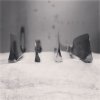I didn't watch the whole thing but it's Dovo, so I'm assuming you're talking at the double wheel wet grinder.
All euro production razors and all of the vintage razors posted are indeed ground on that type of grinder.
Yes, I mean the double wheel grinder.
It must be really skilled workers and good tolerances and setup of the wheels.
Or high percent of rejects.




